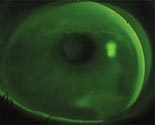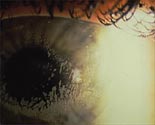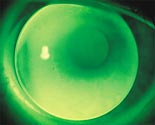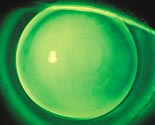Case history is key aspect of managing RGP adherence in daily wear patients
|
The rigid gas-permeable (RGP) market is getting a much-needed boost with the renewed interest in overnight orthokeratology and the recent Food and Drug Administration (FDA) approval of the Menicon Z lens (Con-Cise Contact Lens, San Leandro, Calif.) for 30 days of continuous wear. At the same time, we can’t ignore the benefits of RGP lenses for our daily wear patients.
Superior optics, the ability to correct corneal astigmatism and greater oxygen permeability are all advantages over most hydrogel lenses. RGP contact lens wearers historically experience fewer complications; however, lens adherence is an adverse response of rigid lens wear that can have dramatic and serious consequences if not properly managed. Although the phenomenon has historically been more common with overnight wear, it does occur with daily wear. Several factors contribute to the etiology of RGP adherence.
Traditionally, we have focused our attention on the fitting relationship combined with tear film quality. Of recent interest is the promising data from the 30-day continuous wear clinical trials of the Menicon Z lens. No cases of adherence were reported, and so we should be considering the oxygen permeability of the lens material as playing a role as well. For now, let’s look at managing a case of RGP adherence in a daily wear patient.
Case report
A 26-year-old man presented wearing a pair of RGP lenses that were fit and dispensed 3 years previously. His chief complaints were that his left eye was red and irritated, and vision had been blurry for the past week with his contact lenses and spectacles.
Slit-lamp examination of the right eye revealed an inferiorly displaced lens. With each blink, the upper lid would descend, pick the lens up and return it to a more superior position. However, shortly after completion of the blink, the lens would displace nasally or temporally and descend to its inferior resting position, indicating a flat fitting relationship.
The left lens was displaced inferiorly with the edge extending over the limbus. There was no movement and no penetration of fluorescein beneath the lens due to 360° of seal-off. Additionally, the tear film debris beneath the lens showed the classic fern-like pattern characteristically observed in rigid lens adherence.
A lens-off slit-lamp exam revealed the following significant findings: meibomian “capping” with mild inflammation along the margins, a frothy tear film and moderate injection of the bulbar conjunctiva in both eyes. The left eye displayed central corneal clouding with trace striae, coalesced superficial punctate keratitis at 3 and 9 o’clock and a lens impression ring of fluorescein pooling 360°.
 |  |
| Tear film debris: Debris beneath the lens showed the classic fern-like pattern characteristically observed in rigid lens adherence. | |
Telangectastic vessels on the nose and cheeks were observed during this examination, which led to the suspicion that the meibomian gland dysfunction could be secondary to acne rosacea. Upon questioning, the patient reported that the skin on his nose and cheeks flushed easily and the blood vessels appeared more prominent. He was also prone to frequent clear blemishes and patchy, red, rough skin on the cheeks, chronic hordeola on both the upper and lower lids and frequent dry eye symptoms. An unusual presentation of corneal edema secondary to rigid lens adherence in the left eye, a flat base curve-to-cornea fitting relationship in the right eye and ocular rosacea were the working diagnoses.
Etiology: the “thin-film” theory
Extensive data presented by Swarbrick and colleagues suggests that rigid lens adherence in daily wear is most commonly observed with fitting relationships that create minimal post-tear lens thickness profiles, such as those seen with an alignment fitting or flat and decentered lenses. Swarbrick’s “thin-film theory” is based on the principle that when two surfaces of similar radii of curvature come into close contact with one another, a thin film is created between the surfaces. In the presence of aqueous tear film abnormalities, this thin layer between surfaces can become viscous and mucoid, which increases the possibility of adhesion. A simple analogy is the phenomenon that occurs when two microscope slides adhere when a drop of fluid is placed between them.
|
To rehabilitate the corneal distortion in this patient, contact lens wear was discontinued for 1 week. Lid hygiene and preservative-free artificial tears were also recommended, and we initiated therapy of oral tetracycline to treat the dermatological condition.
After 1 week, the patient’s corneal distortion had completely resolved. Keratometry and a manifest refraction were performed, and the results were as follows: OD –3.25 –1.25 × 010 20/15 43.87/45.50 @ 105 and OS –3.50 –1.00 × 005 20/15 44.00/45.37 @ 105.
The next step was to design a new pair of RGP lenses. The goal of the refitting procedure was to allow greater apical clearance and, therefore, a greater tear volume between the posterior surface of the lens and the anterior surface of the cornea. The base curves of the initial diagnostic lenses were approximately 0.50 D steeper than flat “K,” and the overall lens diameters were 8.8 mm (0.2 mm smaller than his previous lenses).
The ultimate goal of the refitting was an interpalpebral or under-the-lid fit with minimal peripheral alignment, slight central clearance and lens centration. Swarbrick’s data suggests that lens designs that incorporate these features have a decreased tendency of adherence because of the thicker lacrimal lens.
Compliance and follow-up
The patient was educated on the importance of the therapy with tetracycline. It was also reiterated that this is a chronic condition that may occur periodically as acute episodes; therefore, compliance with the medication is important. No evidence of adherence was observed at the 1-week or 1-month post-dispense progress exams.
Eiden and Schnider reported that they observed a mean time factor of about 8.6 months to onset of adherence. As a result of the possibility of delayed adherence, the patient was recalled in 6 months and then again 1 year later.
Case history important
A careful case history is invaluable when investigating the cause of tear film disruption. In this case, it was determined that acne rosacea was involved, and appropriate medical treatment was initiated. Other causes of ocular surface disease such as blepharitis can lead to changes in the tear layer as well as systemic and topical ocular medications.
Finally, hypersensitivity to lens care products should also be suspected, especially if diffuse superficial punctate keratitis is also observed.
The bottom line
The sequelae of rigid lens adherence include corneal distortion, peripheral corneal desiccation, inflammatory-mediated adverse responses and, in this case, an unusual presentation of central corneal clouding. Therefore, when suspected or observed, rigid lens adherence should be aggressively addressed. With a few simple lens design changes and by managing underlying tear film disturbances, most patients are able to return to successful, safe RGP lens wear.
For Your Information:References:
- Jennifer L. Smythe, OD, MS, FAAO, is an associate professor of optometry at Pacific University College of Optometry. She also sees patients in private group practice at Murrayhill Eyecare in Beaverton, Ore. She can be reached at PUCO, 2043 College Way, Forest Grove, OR 97116; e-mail: smythej@pacificu.edu. Dr. Smythe has no direct financial interest in the products mentioned in this article, nor is she a paid consultant for any companies mentioned.
- Swarbrick HA, Holden BA. Rigid gas permeable lens binding: significance and contributing factors. American Journal of Optometry & Physiological Optics. 1987;64:815. Swarbrick HA, Holden BA.
- A possible etiology for RGP binding [adherence]. International Contact Lens Clinic. 1988;15:13.
- Swarbrick HA, Holden BA. Rigid gas-permeable lens adherence: a patient dependent phenomenon. Optometry and Vision Science. 1989;66:269.
- Eiden BA, Schnider CM. Adherence of daily wear RGP lenses. Contact Lens Spectrum, February 1996.


